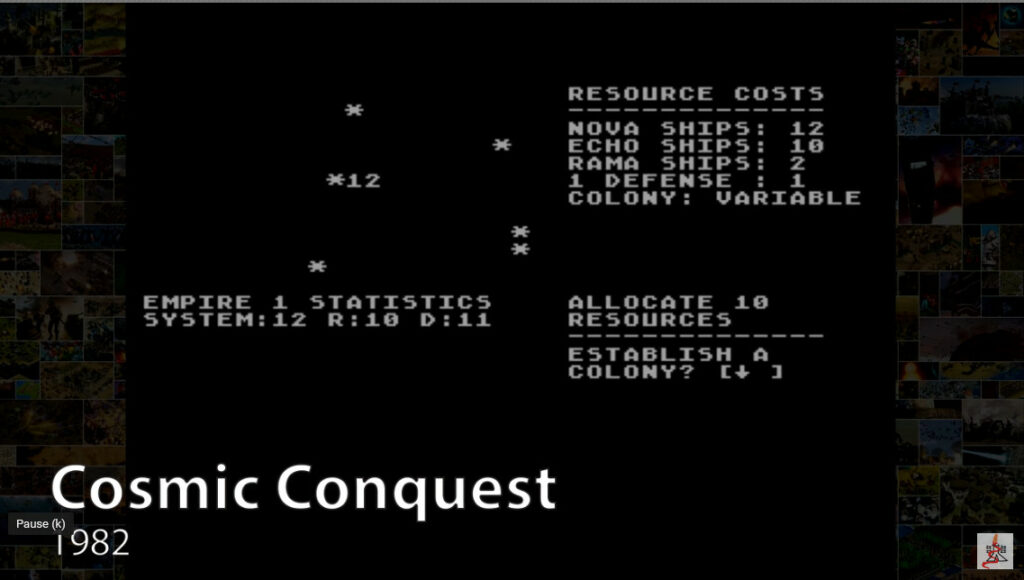
What is the first RTS ? Well, it does not depend on who you ask as much as when you ask. I have covered some of the possible “precursors”: Sea Battle (1980), Utopia (1981), Legionnaire (1979/1982) and Cytron Masters (1982). Nowadays, the most common answer you will find is Utopia, but it was not always the case – the answer to this question has its own history which over time established a canon of games that made the history of RTS.
Up to 2001, there was no “history of RTS”. There was a first RTS, and it was usually Dune II, and if it was not Dune II then the article would mention that one RTS that came before Dune II. But because early video game journalists did not have Wikipedia, a host of YouTube “Let’s Play” videos or extensive videogame databases to work with, they could not easily read one another and so they never agreed on which was that precursor before Dune II. Looking back, some of the proposals were pretty spot on (Ancient Art of War, Herzog Zwei), others more surprising (Harpoon!?). This changed in the early 2000s with the arrival of websites dedicated to videogame journalism, allowing everyone to find an existing list, and then improve it by either removing unworthy games or one-upping other contributors with an even earlier RTS.
The first attempt at a history of RTS I could find was from Gamespot in 2001, which stated that Herzog Zwei (1989) was the first RTS, something confirmed by GameSpy in 2002. Why Herzog Zwei ? Probably because it was the earliest real-time game that looked like Dune II (1992), the game which codified the genre. Of course, “real-time strategy” encompasses a lot more than just Dune II-like, and in 2006, IGN made a breakthrough by remembering the Ancient Art of War (1984) :
“Broderbund’s The Ancient Art of War was actually the first RTS (unless I’m missing an earlier one) for DOS way back in 1984.”
Ancient Art of War was not considered the most ancient RTS for long : in 2007 Matt Barton for GameDeveloper.com mentions Cytron Masters (1982), though at the same period Cytron Masters is sometimes shunned by articles (and at least one 2003 book) in favour of Stonkers (1983).
At this point in time – and let me tell you I checked pretty much every single printed book or website from 2001 to 2007 I could find – Utopia is always described as “the first sim game“, never as the first RTS.
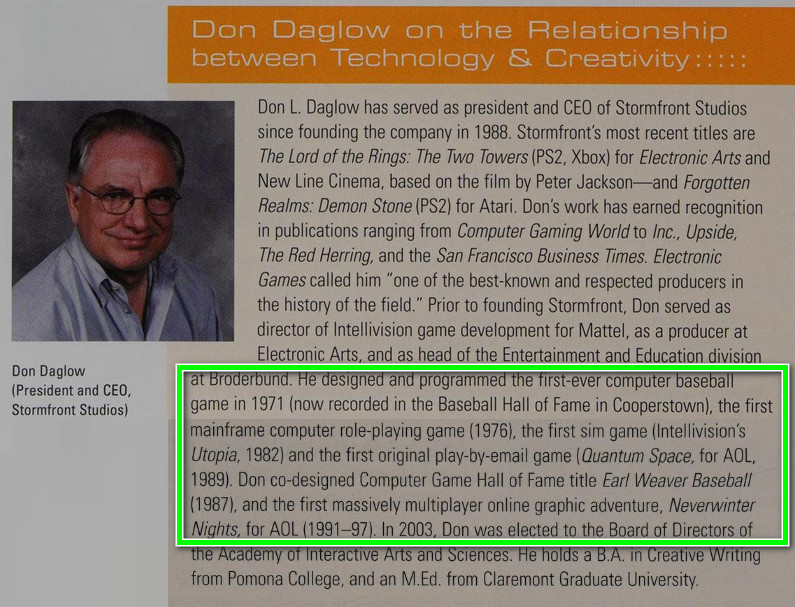
Utopia starts appearing on the RTS list somewhere between 2009 and 2011. In 2009, the Guinness Book of World Records, Gamer’s Edition stated Utopia was the first God game (and again Stonkers is the first RTS). Meanwhile in Vintage Game (2009) Matt Barton (again) and Bill Loguidice add Utopia to the list of pioneers that opened the way to Dune II, though not really a RTS :
“Utopia ultimately has more in common with SimCity than Dune II and later RTS games. SimCity and Populous were certainly better known than Utopia, and were widely admired by critics and gamers alike in the early 1990s. Although these games were not focused on combat, they did feature many of the elements that would become established conventions of the RTS genre.
And finally, in 2011, Roberto Dillon in The Golden Age of Video Games and Brett Weiss in Classic Video Games 1972-1984 finally added Utopia to the list as either a precursor (Dillon) or the first (Weiss) RTS. In fairness, I was not able to source the 2007 edition of Weiss’s book, so possibly Utopia is already listed as the first RTS there, but if Weiss shot first, he was probably an isolated voice then.
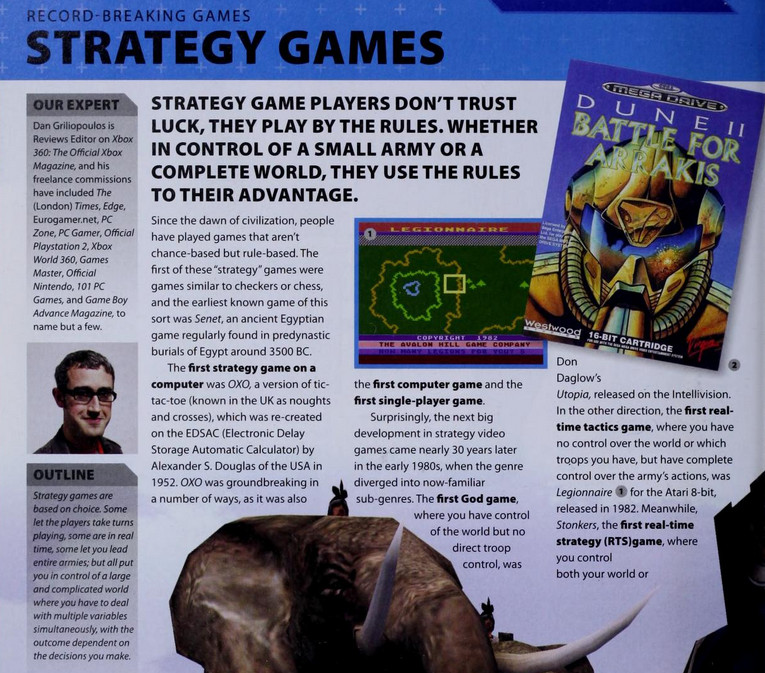
It took a few more years for “Utopia the first-ever RTS” to become a part of the canon, but by the mid-2010s it was there. The current canon used by both journalists and YouTubers is all but formalized by a 2017 ArsTechnica article (Build, gather, brawl, repeat: The history of real-time strategy games) and goes like this :
- Utopia (1981) is the earliest ancestor/pioneer/precursor,
- Cytron Masters (1982) is the first prototype of a recognizable RTS,
- Herzog Zwei (1989) is the first RTS immediately recognizable today by our current expectation of the genre, if not the first “modern” RTS,
- Dune II (1992) is the trope codifier,
- Finally, if there is some space left in the article or some time left in the video, some or all of the following will be mentioned as “contributing to the genre” or any other laudatory acknowledgement: Legionnaire (1982), Stonkers (1983), Ancient Art of War (1984), Modem Wars (1988) and Populous (1989).
This canon seems to correspond quite closely to the state of the research in 2015 (for instance this thesis in French, short version in English there). For three examples of 2018 articles using this canon (with their own additions, of course), check the Wertzone , VGChartz or PCGamer.
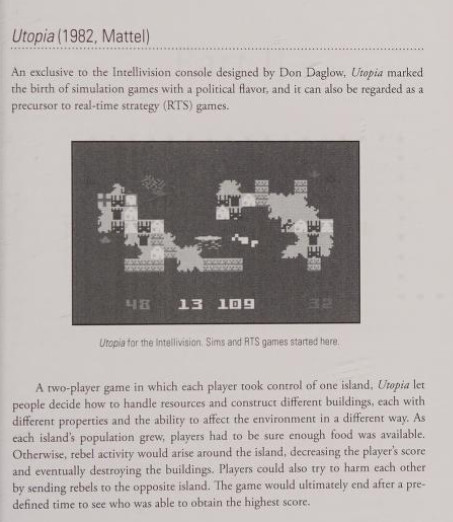
What the history of the canon illustrates is how subjective “first RTS” is, and not only due to the fluid definition of RTS. Games that make it to a coveted list of “early RTS” tend to stay there, as lists are built on earlier lists. Games that were forgotten get remembered become someone adds them to a Mobygames list. Games are omitted because they don’t make for a good narration or good screenshots : if Utopia qualifies, I don’t see why Sea Battle (1980) does not, but then the first precursor becomes a game much less impressive visually and conceptually. But the most obvious example of these choices, conscious or not, is the inclusion of the 1982 edition of Legionnaire, but not the 1979 one (possibly because it is lost) nor of the 1981 clone Centurion.
One new game is currently gnawing its way into the canon – a game that was hitherto forgotten.
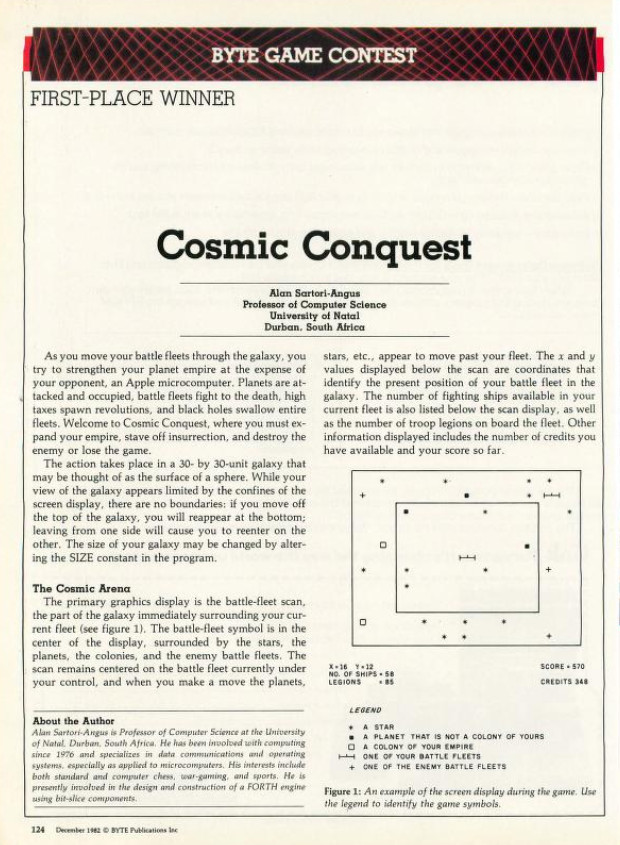
Cosmic Conquest is a type-in game published by BYTE magazine in December 1982 and developed by Alan Sartori-Angus, “professor of Computer Science at the University of Natal, South Africa” who won the design competition organized by BYTE. The catch is that the game was coded in FORTH, a language popular in the early 80s because its efficiency made it well suited for the era of low memory, but rarely used since then. A game in FORTH must have been, back then, less popular to type in than a game in BASIC, especially since it needed a dedicated FORTH compiler. For this reason, while most type-in games have versions circulating around without anyone having to go through the hassle of typing anything, Cosmic Conquest had none. The initial window of opportunity was missed and later the game failed its save roll of archeogaming : as FORTH evolved and the type-in code used features specific to the Apple II, it required increasing FORTH skill to turn the written code into something functional, but meanwhile FORTH had faded in popularity. In the first half of 2021, there was no working version of Cosmic Conquest, no video of anyone playing Cosmic Conquest, not even screenshots of Cosmic Conquest ! As I write this article, Cosmic Conquest is still not on Mobygames.

The timeline of events makes me believe we owe the rediscovery of Cosmic Conquest to archive.org. In September 2012, the super-archivist Jason Scott uploads a copy of the BYTE magazine on archive.org. In 2013, Cosmic Conquest gets added to Wikipedia with a link to archive.org. And in 2014, lo and behold, we start to see Cosmic Conquest mentioned in a research paper for the first time, though it is also possible that the authors checked archive.org for early mentions of the words “real-time strategy”.
In any case, more research papers from more authors follow, none of them offering any indication that they actually played the game – some indicating very much that they did not. See for instance this research paper from 2015 :
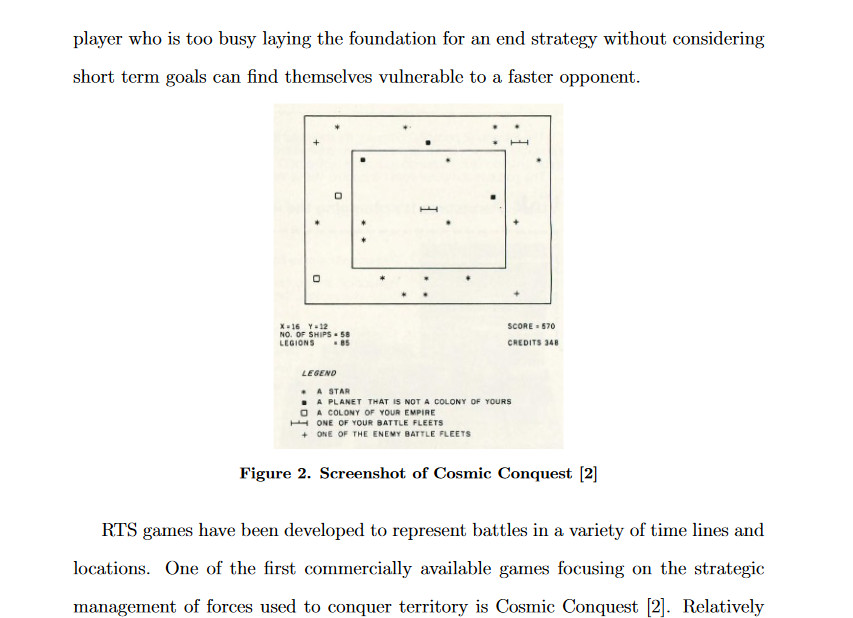
More like Figure 2. Screenshot of archive.org
Then Cosmic Conquest reached the videogame journalists. ArsTechnica does not mention Cosmic Conquest in its article, but two of the three 2018 articles do. Doing so, VGChartz earnestly admits that “however, I could not find a single video or image from the game, so how exactly it looks or plays is anyone’s guess.” but the Wertzone either makes up or repeats a bald-faced lie and explains : “Cosmic Conquest (1982) was the first game to be called a real-time strategy game and codify some of these elements.” Let me manage your expectations right now : It did not codify anything and does not amount to much. Youtubers followed, with of course the problem that they lacked visuals. You can see in the first image of this article that at least one significant youtube channel (>1.4 million subscribers) simply showed Andromeda Conquest and dubbed it Cosmic Conquest; no one will know, right ?
As I saw Cosmic Conquest in my list, I realized it was going to be difficult to review. I thus posted a pleading message on a forum of FORTH developers in mid-2021. The magic of the Internet did the rest. An ad hoc team led by Rick Carlino ported a playable version to modern Forth. Rick Carlino’s version is the closest to the original, though choices had to be made (speed of the game, plus by what to replace some graphical assets which were native). From then, the game branched : tmr4 made an improved version with a better UI and Camel99-V2 even ported the game to Ti99/4A. I only managed to play Rick Carlino’s version.
Conquering the Cosmos
I start my campaign immediately with the first of my two fleets next to a force belonging to the enemy Empire – and the fact that they are a spacefaring Empire represents 100% of what I know about my enemy.
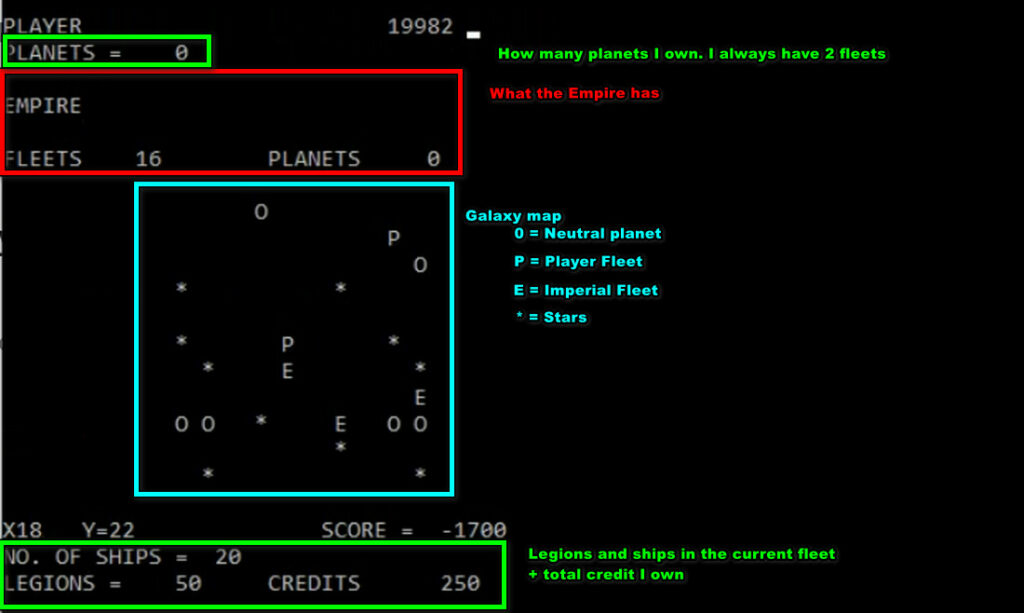
I have 20 ships in my fleet, and in my experience that’s more than enough to beat one imperial fleet, so I promptly attack it three times. I lose 8 of my 12 ships, but the enemy fleet is gone. One down, 15 left.
I don’t have time to lose, so I beeline immediately to the group of planets seemingly about to be colonized by another imperial fleet and attack the world on the left with my own legions :

After losing a few legions, the planet is mine. I can now call the planet menu, which conveniently pauses the game. From this menu I garrison the planet with a few legions, but also buy more ships, which I use to attack the nearby imperial fleet. Two enemy fleets down ! I colonize the world next to my first planet, losing no less than 14 legions. As I leave what’s left of my men as a second garrison, I am done with the fleet for the time being and switch to my second fleet for a fresh force.
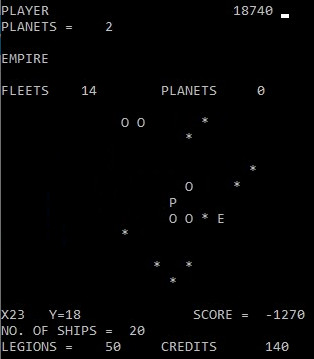
The second fleet also starts with 50 legions, which is sufficient to conquer 2 neighbouring worlds. It also annihilates the nearby imperial fleet.
After this, I can start garrisoning the planet and recruiting, though I quickly run out of credits :
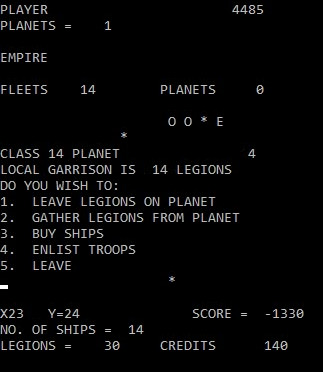
No big deal ! I can tax the 4 planets I own. Of course, the locals may object, but I put garrisons everywhere for a reason :
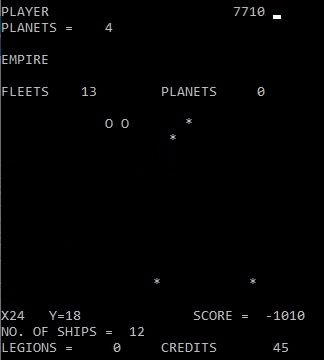
After the first round of taxes, I can reinforce the garrisons further and then tax some more without the risk of another revolt, and quickly I have quite the war chest.
It is time to mention the key issues with the game :
- Firstly, and this is as designed, planets don’t remember when you last conscripted them. Every visit, you can either build ships or conscript a limited number of people, after which you need to move 5 times before being able to rebuild / reconscript from any world.
- Secondly, and this one is kind of a big deal for a claimant to the RTS-title : enemy fleets don’t move. Sometimes, new enemy fleets are created or a planet flips to the empire for no discernable reason, but that’s all the activity the Empire is able to muster.
The combination of those two issues means that the game has absolutely no time pressure – as long as you can tax, recruit and garrison faster than the planets revolt, you’re good. I spend some time doing exactly that around the few worlds I own, then buy a lot of ships, and start exploring with my 44-ships strong fleet.
The map wraps itself up horizontally and vertically, which means that the cosmos has the shape of Britannia in Ultima VII a 30×30 doughnut.
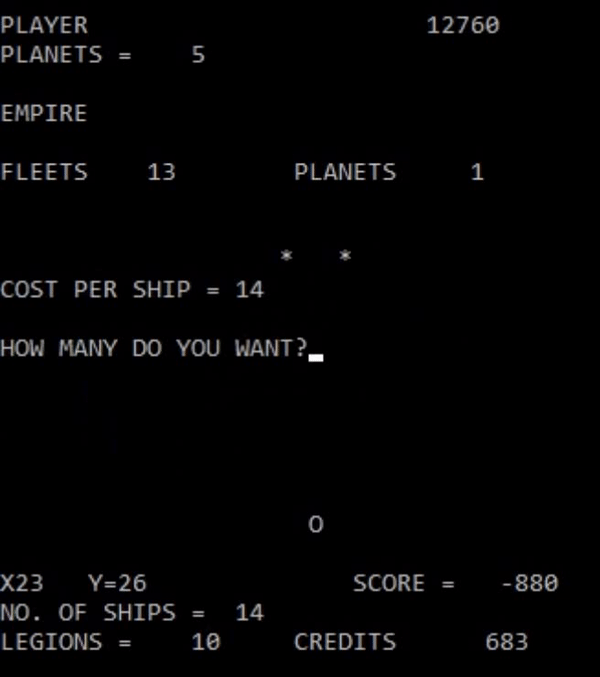
44 ships are not enough to wipe out all the enemy fleets, so I just relaunch the tax/recruit/garrison cycle, and soon I have 70 ships in my fleet…
… and suddenly I have 0 !

Black holes are static but invisible, and reduce your fleets to 0 legion and 0 ships (your fleet can never be fully destroyed, it is just “empty”). This means I must, for one last time, reengage in the taxation cycle, and conquer what’s left of the cosmos, including two imperial planets defended by 40 legions.
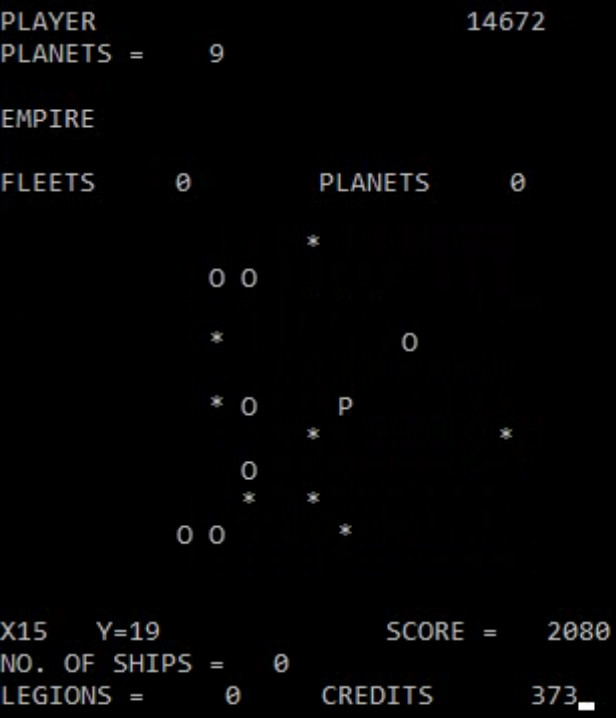
Last limitation of the game : there is no end screen, so we will stop there, with the Empire totally crushed.
Again, all my thanks to Rick Carlino but also to the people who helped him (Gordon JC Pearce and tmr4) for allowing me, and really everyone, to actually test the game.
Rating & Review
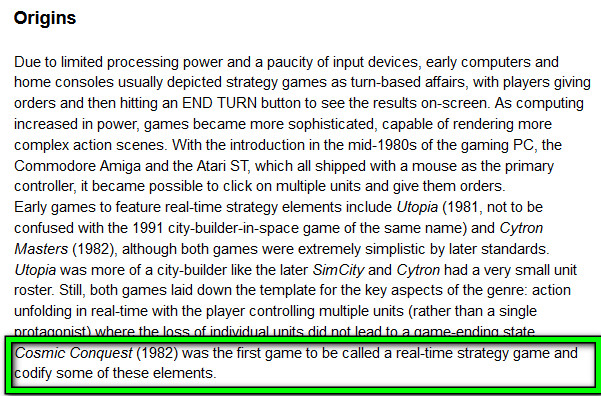
Cosmic Conquest, by Alan Sartori-Angus, published by BYTE, ported by Rick Carlino, Gordon JC Pearce and tmr4
First release :
December 1982 for Apple II
November 2021 for the first modern port on GForth
Tested on : Windows // Gforth
Total time tested : 1 hour
Average duration of a campaign: 20 minutes
Complexity: Easy (1/5)
Would recommend to a modern player : No
Would recommend to a designer : No
Final Rating: Totally obsolete
A. Immersion
None whatsoever. Note that the graphics used in my version are not the ones of the 1982 version, as I understand the latter used native Apple assets that could not be reproduced, but then native Apple assets were not pieces of art either.
Rating : Terrible
B. UI , Clarity of rules and outcomes
For such a simple game, the UI is also suboptimal. The planet menus occupy the whole screen, and numbers don’t update when they should. For instance, if you buy troops on a planet, the UI will only update after you leave the planet, which can be confusing when you also want to leave a garrison. The fact that the game keeps pausing to deliver messages is also irritating for a “real-time” game.
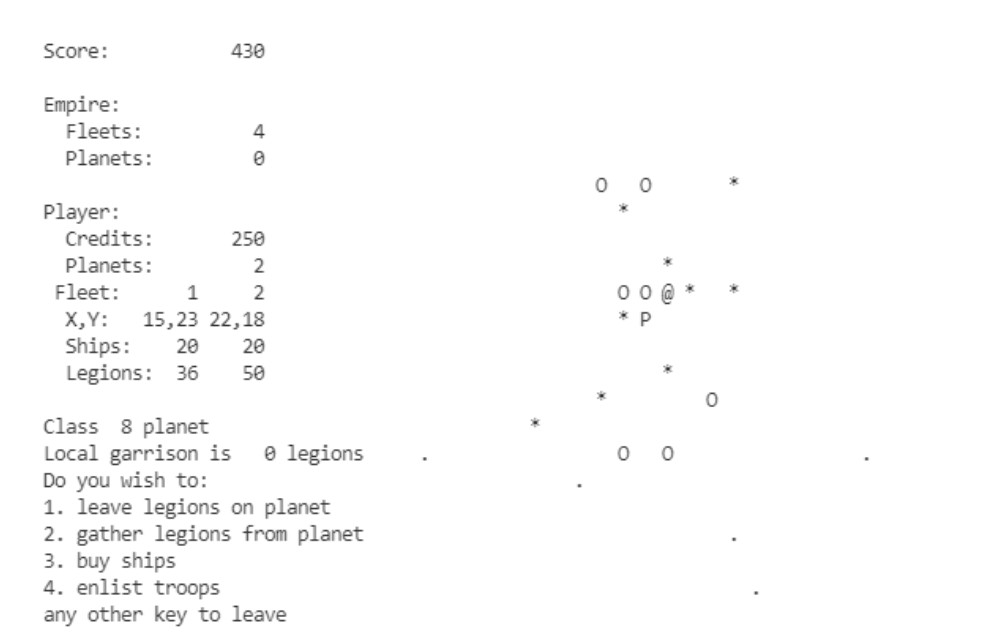
The most important UI flaw borders on a design issue. In most RTS, you give orders to units, and they start moving on their own until they are destroyed or complete this order. In Cosmic Conquest, every movement is manual, so while you move your first fleet the second fleet has to stay put – exactly like in a turn-based game.
Rating : Very poor
C. Systems
The loop of the version I played is simple, and reminds me a lot of Brøderbund’s Galactic Empire. The player must conquer planets to build either legions (with a maximum per planet) or ships (with no maximum, but shipyards are everywhere), all paid by taxes levied on the same planet. Legions conquer planets, and of course, ships defeat fleets. Finally, while in Galactic Empire you could tax a planet every time you visited, in Cosmic Conquest you can recruit on a planet every time you visit, provided you made 5 movements since the last visit.
In theory, you need to balance growth and garrison. In practice, you only need a few planets to generate enough wealth to conquer the whole map, especially since even at maximum difficulty the growth of the Empire is sluggish. That’s sad, because the planets are well-designed, with different “class” of planets :
- Low-class planets are easy to conquer (I lost 3 or 4 legions), bring little tax, and offer few legions to recruit every visit, but these come as a very low price (for instance, 6 legions for a price of 5 each),
- High-class planets are the opposite – well-defended, highly taxable, lots of recruits available, but you must pay the price,
Again, sadly, given you are not constrained by time and that planets regenerate every 5 movements, the only reason you will pay the higher price is that you don’t want to be hassled by small transactions.
The game is theoretically real-time – if you let it run in the background the Empire will eventually conquer the universe. But this is all smoke & mirrors, the underlying logic is turn-based :
- as I explained, the Empire does not move, it justs spawns fleets and take control of planets remotely over time,
- you can move as fast as you can mash the movement buttons,
- no resources is ever accrued while you wait and you get the same taxes from a planet whether you waited one second or 10 minutes since tax collections,
- you will never have to use your second fleet except to spend the legions and ships it initially contains,
Rating : Terrible
D. Scenario design and balancing
Your only choice is how large you want the world to be and whether you want the game to be easy or difficult, but even the hardest difficulty is trivial. And of course, no AI.
Rating : Terrible.

E. Did I make interesting decisions ?
No.
F. Final rating
Totally obsolete.
G. So, is it a RTS ?
Cosmic Conquest only passes the weakest possible test to be a RTS : it is a strategy game, and it does not have turns. If that’s the threshold we use, then Galactic Empire (1979), Galactic Attack (1980) or Tawala’s Last Redoubt (1981) are also RTS and Cosmic Conquest is nothing special.
If the enemy fleets had moved in real-time, then Cosmic Conquest would have had a better claim for sure, but still it would have been a weak precursor compared to the slightly earlier Cytron Masters or Legionnaire. Unlike those games, none of the gameplay logic would have been converted to real-time, and Cosmic Conquest would still not have anything we should expect from RTS : units moving and/or attacking on their own once an order has been given, resources being produced over time and automatically, … In a nutshell, either one stretches the definition of RTS so much that the first RTS for PC arrived in 1979 and then Cosmic Conquest is not a precursor, or we consider that RTS is a little more than “something happens in your game while you go grab a cup of coffee“, and then Cosmic Conquest is not a RTS at all.